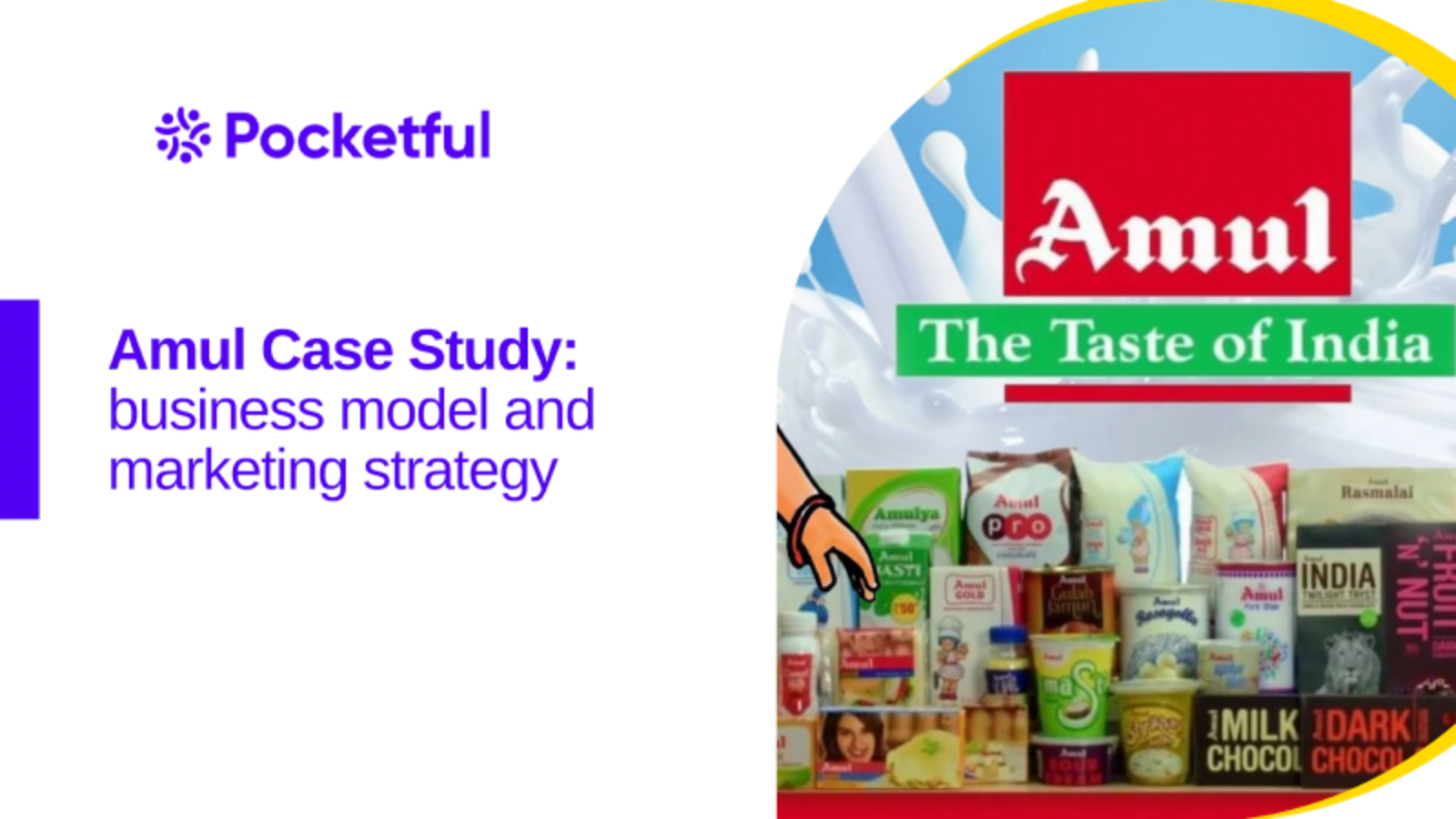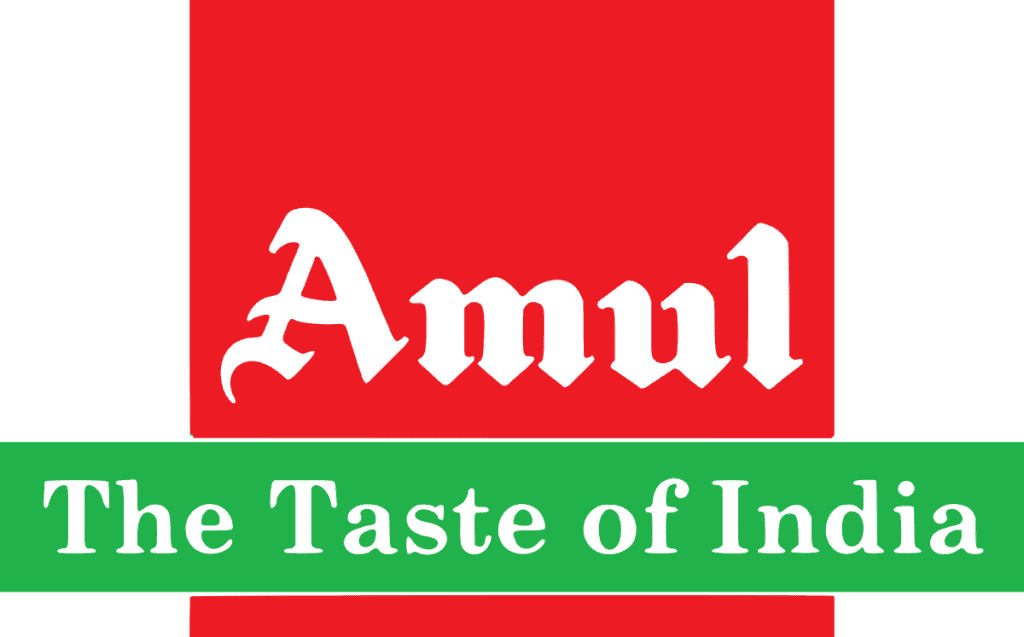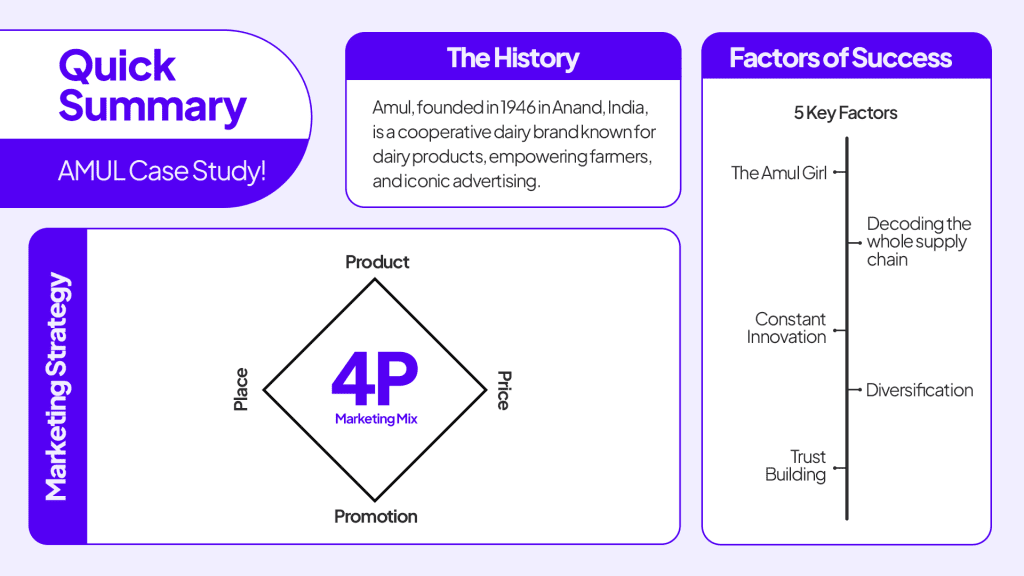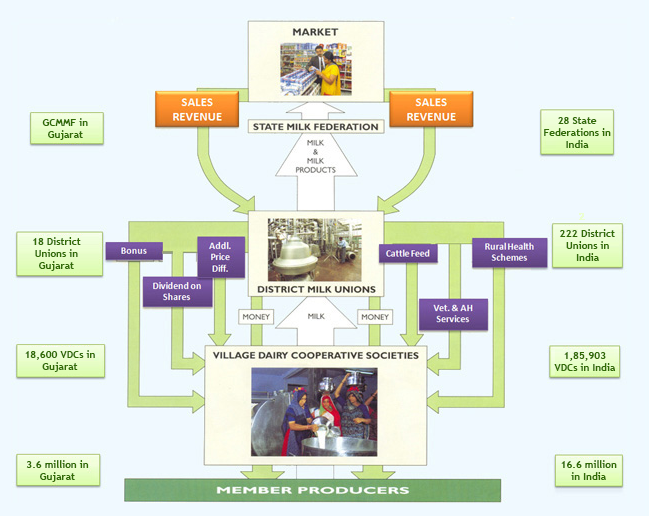| Type | Description | Contributor | Date |
|---|---|---|---|
| Post created | Pocketful Team | Sep-18-23 | |
| Update Content | Nisha | Mar-20-25 |

- Blog
- amul case study business model and marketing strategy
Amul Case Study, Business Model, And Marketing Strategy

All about AMUL

Amul is an Indian milk cooperative society based out of Gujarat. It is under the ownership of Gujarat Cooperative Milk Marketing Federation Limited, Department of Cooperation, Government of Gujarat. Today, it is controlled by 3.6 million milk producers. Mr. Tribhuvandas Kishibhai Patel laid the foundation of Amul in 1946. Later, Verghese Kurien joined Mr. Patel as the general manager to manage and assist the marketing and technical department of the cooperative. After Mr Patel died in 1990, Kurien became the chairman of Amul and the face of its success.

History of Amul
The main motive behind the commencement of Amul was not profit-making but a fight against the exploitation of Polson towards the Dairy farmers. Polson is the name of a dairy products brand that was started in India by Pestonjee Eduljee in 1915 in Mumbai. Dairy farmers of Kaira, along with Mr Tribhuvandas Kishibhai Patel, went up to Sardar Vallabhbhai Patel to get a solution for the exploitation they were facing by Polson because the prices of the milk were fixed arbitrarily by the Giant, making it very hard for the Dairy farmers to make ends meet. Sardar Vallabhbhai Patel advised the farmers to form a cooperative and sent Morarji Desai to organize the farmers.

After a meeting in Chaklasi, the farmers formed the cooperative and decentralised the whole milk pooling system. Most of the farmers were only able to provide 1-2 litres of milk daily. They were the ones who most benefited from the formation of the cooperative. Later, this cooperative was named AMUL (Anand Milk Union Limited) under the leadership of Mr.Tribhuvandas Kishibhai Patel.
Seeing the success of Amul in the Anand district, neighbouring districts of Mehsana, Banaskantha, Baroda, Sabarkantha, and Surat were set up with similar cooperatives, and this was sometimes described as the Anand Pattern.
White revolution & AMUL
White Revolution popularly, known as Operation Flood, was a government-led initiative with the Spearhead cooperative Amul. The main aim of the revolution was to increase the milk production in the country. Indeed, it was a significant success for India, since India ended up being the top producer of milk and milk products in India. In 1973, an apex body called the Gujarat Co-operative Milk Marketing Federation Ltd was set up to facilitate the marketing of these district cooperatives. The world’s biggest dairy development program, led by Dr. Verghese Kurien. ‘Operation Flood’, as it is otherwise known, transformed the dairy-deficient nation into the global leader in milk production. For the millions living in rural India, milk farming became the largest source of employment and income.
During the 1960’s India had the highest cattle population, & yet India stands among the lowest milk producers in the world. Between 1961 and 1970, the nation had to be dependent on imports to fulfil their dairy needs. The idea behind the white revolution was simple, eliminate the middle man, directly connecting the consumers with the dairy farmers. When farmers were getting a better price for their product they felt incentivized. Hence, they were willing to increase the production of milk, and other milk products. With the combined success of Amul and the white revolution, Mr. Verghese Kurien went on to be called as the milkman of India. The dairy engineering graduate transformed a dusty little town in Gujarat into the milk capital of India.
Read Also: D Mart Case Study: Business Model and Marketing Strategy
5 Key Factors That Led to the Success of Amul
1. Amul Girl
Utterly, buttery, delicious! I bet almost all of us have heard this jiggle at least once in our lives. Or have noticed that vivacious little girl on the packs of Amul butter? She became the ultimate advertising mascot for Amul to date. Amul has smartly used the girl mascot to advertise their brand associating it with humour and and how children like everything with butter. Hands down, even today, it is still remembered as one of the best marketing campaigns.
2. Decoding the Whole Supply Chain
One of the main and biggest reasons for Amul’s success was that they managed the whole supply chain of milk production so efficiently. Starting from the pooling of milk from various small dairy farmers to supplying it to the end consumer. Amul follows a three-tier cooperative structure which consists of a dairy cooperative society at the village level that is affiliated with milk unions at the district level, which in turn is federated to a milk federation at the state level. Milk is collected at the village dairy society, procured and processed at the district milk union and marketed at the state milk federation.
3. Constant Innovation
Today Amul has over 2000+ products under its brand name. Started just as a milk cooperative is today the biggest gaint in the milk and dairy product segment. And it’s not just about its product line but also its marketing campaigns and strategies. Their most recent social media campaign #BEMOREMILK is gaining popularity immensely.
4. Diversification
With daily constant efforts, Amul managed to carter every dairy-related segment. Making products for the needs of the kids, men, women, health conscious & taste conscious. You name it & they have it. Through consistent efforts, Amul has managed to have a diversified portfolio in terms of products & it is very hard for any new player to enter the market.
5. Trust Building
By delivering the best quality products at low rates, Amul has built trust and brand loyalty among its target market. Also, a fact to notice is that Amul was the first company to offer condensed milk at affordable prices and made a significant mark among the lower-income group.
Business Model of Amul

So Amul follows a three-tier business model to provide milk to us. The first tier is the village dairy cooperative society, next is the district milk unions & then there is the state milk federation.
Village Dairy Cooperative Society
This is the lower and the first tier of the business model of Amul. Here, local daily farmers come and pool their milk. Depending upon the quality of milk, it is segregated and accordingly is supplied ahead to the next tier i.e. district Milk unions.
District Milk Unions
The milk is then brought to the district milk union centres for processing and packaging. Here the quality of the milk is checked and tested, whether it is fit to be delivered to the market or not. Then the milk is graded depending on its properties like fat concentration, water concentration, nutritional value etc.
State Milk Federation
This is the last and the final stage of milk production. Here, the packaged milk arrives, which is distributed to the suppliers for supplying it to the retailers. Here the manufacturing of the other dairy products takes place. And the final product is delivered to the market.
4P’s of Amul Marketing Strategy

1. Product Mix
Amul offers a wide range of products to its customers making it a trustworthy brand among consumers. The cheese and the ice cream segment of the amul are their cash cows. Contributing a significant share in the revenue of the business. Also Amul Ice Cream is among the top 10 ice cream brands in India. Recently amul has also entered the chocolates and lactose-free dairy product segment to cater for the needs of the changing India.
2. Price Mix
The pricing strategies of Amul include a combination of competitive and low-cost pricing. Amul began with the vision to provide the best quality dairy products at affordable prices. The pricing of different products is taken into account by different factors such as the price of raw materials, labour cost, farmer’s profit, transportation cost and storage costs.
Amul is pursuing a low-cost strategy for products commonly used like milk, ghee, butter and so on, where they offer these products at a lower price than their competitors. For products like Amulspray, Prolite, condensed milk and more the company adheres to a competitive pricing strategy, where the price of these products is similar to their competitors.
3. Promotion Mix
Amul is one of the few cooperatives that consistently deliver memorable brand promotions to the audience leaving a long-lasting impact. Like the world-famous Amul girl designed by Mr. Eustace Fernandes or the jingles like utterly buttery delicious Amul! And their iconic tagline the taste of India. The way Amul incorporates the humour of the cartoons in delivering heartfelt messages is commendable.
Their recent cartoon tweet to celebrate the success of Pathan a Shah Rukh film was also catchy.
4. Place Mix
Amul distribution channel takes place through 2 mediums. First is the procurement of the milk. Farmers provide milk to cooperatives, and milk is gathered in bulk and transported to the processing plant. That milk is used to produce the final goods at the production plant. The second channel is In charge of getting the finished product to the end-users. Carrying and forwarding agencies, distributors, dealers, and retailers are all part of the distribution chain.
Read this also – Are ETFs good for beginner investors?
Sustainability Practices
After its success in the dairy industry, Amul has recently focused on green energy initiatives. Some of its efforts to promote sustainability are:
- In 2023, Amul announced that the cooperative has been working towards building a circular economy that will feature the collection of dung from farmers and convert it into biogas, which can be used as a fuel for cooking, automobiles, etc. Moreover, the leftovers from the biogas manufacturing can be used as natural fertilizers, thereby promoting organic farming practices.
- 3.6 million dairy farmers in Gujarat have been actively participating in the tree plantation campaigns and have planted more than 733 lakh trees between 2007 and 2019. The most amazing feature of the campaign was that it was not limited to the planting of the sapling; rather, the farmer who planted it took responsibility for the tree sapling until it grew into a tree.
Read Also: CAMS Case Study: Business Model, KPIs, and SWOT Analysis
Conclusion
Amul’s success story is a testament to the power of cooperative entrepreneurship and innovation. From its humble beginnings as a dairy cooperative in Gujarat to becoming a global leader in dairy products, Amul has revolutionized the industry. Through its efficient supply chain, diverse product range, impactful marketing, and sustainable practices, Amul continues to thrive, benefiting millions of farmers and consumers alike.
FAQs (Frequently Asked Questions)
What is the full form of AMUL?
AMUL stands for Anand Milk Union Limited.
Who is the owner of Amul?
Amul is cooperative and is not owned by any single person.
Which state is associated with Amul?
Amul is a cooperative in association with the Gujarat Government.
Is Amul an Indian Brand?
Yes, Amul is an Indian brand.
How many products does Amul have?
Amul has roughly 2,000 products under its brand name.
Disclaimer
The securities, funds, and strategies discussed in this blog are provided for informational purposes only. They do not represent endorsements or recommendations. Investors should conduct their own research and seek professional advice before making any investment decisions.